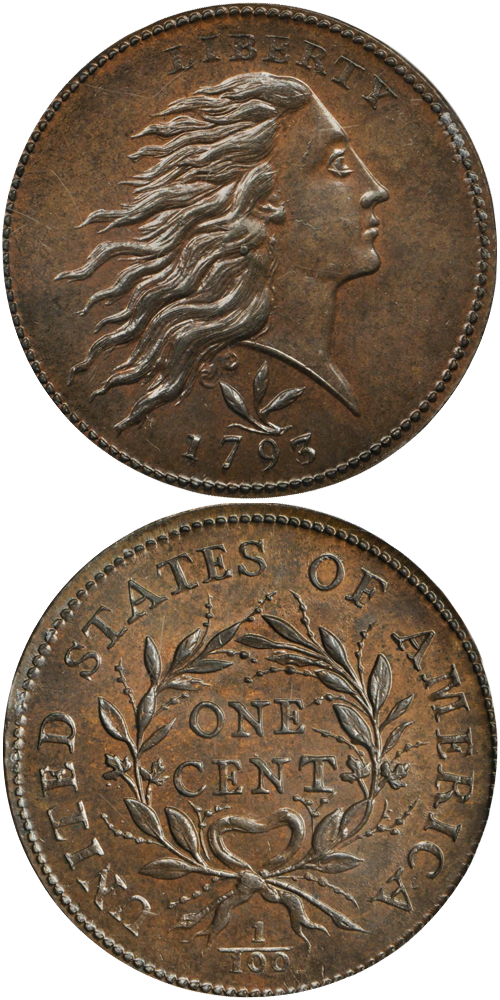1793 Flowing Hair Wreath Cent
Vine and Bars Edge
The Wreath Cent is the second design type issued for large cents in 1793; the first was the Flowing Hair obverse with Chain style reverse. Newspapers and the public criticized the Chain design, and stated that "Liberty was in chains." Mint Director David Rittenhouse ordered new designs for the cent and the Wreath reverse was born. (Only the Birch and Voigt cents of 1792 have a leafy sprig below the bust and above the date, along with the 1793 half cents, perhaps pointing to a common designer.) Liberty herself is more defined after the shallow relief seen on the Chain cents, with more voluminous hair executed in high relief and a steady gaze upward. The reverse wreath leaves include a trefoil style which may be a cotton leaf, while the berries are arranged on long strands, some of which fork into branches with attached berries. The longer leaves depicted are almost certainly laurel leaves, the same species of laurel (laurus nobilis) native to ancient Greece that was used to crown the victors of local sporting events. This tradition of the laurel wreath may have been used to symbolize America's freedom won through the Revolutionary War.
The identity of the designer of the Wreath cent is uncertain and various candidates have been advanced, none with certainty. Just a few months after this design was introduced, the Wreath style was abandoned when the talented engraver Joseph Wright was secured by the Mint in the summer of 1793. Wright completed a third new design for the 1793 cents known as the Liberty Cap style and these were adopted late in the year. Tragically, Wright died in the yellow fever epidemic a few months after he was hired. The total mintage of the Flowing Hair, Wreath cents is thought to be 63,353 pieces by analysis of deliveries and dates. Perhaps somewhat more than 2,000 exist today, with only 30 or so examples in Mint State.
We have always loved 1793 cents of the four major types -- Chain AMERI., Chain AMERICA, Wreath (as here), and Liberty Cap. Of the four, indeed unique within the entire large copper cent series, the 1793 Wreath is in wonderfully dramatic high relief, as previously stated, the portrait of Liberty being almost sculptured in its appearance. Although no documentation survives, likely it required special attention and effort to strike these up properly on a hand press. We can imagine a high rejection rate. The obvious solution was to lower the relief of the designs, which indeed was done when the Liberty Cap variety was introduced later in the year. In any numismatic season a 1793 Wreath cent is an object of desire. Even if worn nearly smooth, such a coin commands interest and attention.
When numismatics became a very popular hobby in 1857 and 1858, following the passing of the large copper cent and the introduction of the small Flying Eagle cent, there was a nationwide passion to collect the pieces of an earlier era -- the large copper cents generating fond memories of childhood. Dr. Montroville W. Dickeson in the first large-format American book on the hobby The American Numismatica Manual, 1859, mentioned that well-worn 1793 cents could still be found in circulation! This did not last for long, and almost as quick as a wink, all disappeared.
There were no magazines on American numismatics, so public interest and questions were addressed by features in magazines and newspapers of general interest, including Historical Magazine, launched in 1857, and in newspaper submissions in New York City by Augustus B. Sage and in Boston by Jeremiah Colburn. Along the way some nicknames for cents that endured such as Booby Head and Silly Head for varieties of 1839 were attached. In 1858 George Cogan, an English immigrant who conducted an art shop in Philadelphia, had a mail bid sale of large copper cents. The leaflet was distributed to those interested, bids came pouring in, and Cogan was startled at the enthusiastic response as well as the prices generated. This prompted him to thinking. Within a couple of years Cogan left the business of prints, painting frames, and the like behind and went into numismatics primarily. Later, he moved to New York City, the center of attention in the marketplace. As years went on, large copper cents continued to be the focus of interest for many collectors and the first photographic plate to appear in The American Journal of Numismatics (launched in 1856), was published in 1869 and featured cents of the 1793 date.
As the years went on, these pieces continued to be the focus of specialists whose names are remembered today. Into the 20th century the momentum continued. Most numismatists collected 1793 cents by the types listed in A Guide Book of United States Coins, one each of the four designs. A notable exception was Dr. Charles Ruby, a university professor in Southern California, who felt that if four 1793 cents were desirable, 10 were better yet, and dozens even more desirable! The coin market evolves, and today with certification led by PCGS and NGC, high grade coins have become a greater focus of attention than ever before. While opinion can still differ, the PCGS and NGC certifications have been widely accepted and linked into various market commentaries.
The example to the left was sold by Stack's Bowers Galleries in the January 2013 Americana Auction, where it realized $558,125.






